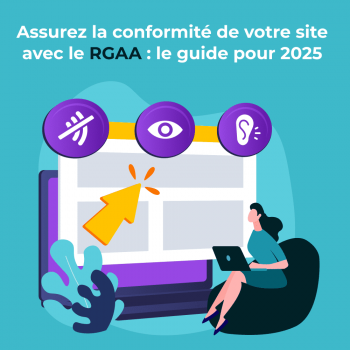Consent Mode V2 is an important update offered by Google as part of its efforts to comply with data protection regulations, including the GDPR (General Data Protection Regulation) in Europe. This update specifically concerns the management of cookies and user tracking on advertising platforms such as Google Ads.
Consent Mode V2 was introduced at the end of 2023, and from March 6, 2024, the use of a Consent Mode v2-compatible CMP (Consent Management Platform) will become mandatory for tracking European audiences with Google Ads.
What is Consent Mode V2?
Consent Mode V2 aims to enable advertisers to continue tracking users effectively while respecting their privacy and consent preferences. In concrete terms, this works by adjusting the way cookies are used for ad tracking according to users' consent choices.
Difference with the previous version of Consent Mode
The main difference between Consent Mode V2 and the previous version lies in the way data is processed. With the previous version, users had the choice of whether or not to consent to ad tracking, but their decision could result in a significant loss of data for advertisers, limiting the effectiveness of their campaigns.
In other words, even if a user chooses not to consent to ad tracking, Consent Mode V2 still enables the collection of certain limited information that may be useful to advertisers, such as the context of the page the user is on. This enables advertisers to obtain more precise data while respecting users' privacy choices.
With Consent Mode V2, Google proposes a more nuanced approach. Rather than simply blocking ad tracking if consent is refused, this new version allows certain data to continue to be collected within user-specified limits, while respecting the user's privacy preferences.
Nature of data collected with Consent Mode V2
Google's update to Consent Mode V2 introduces a more refined management of user consent, allowing the collection of certain data even in the absence of explicit consent for ad tracking. This data, though limited, plays a crucial role in maintaining the effectiveness of advertising campaigns while respecting users' privacy. Here's a more detailed exploration of the nature of this data:
Aggregated data
Aggregated data is information combined and processed to reflect a group or category of users, without identifying people individually. As part of Consent Mode V2, Google may collect aggregate data that provides insights into the behavior of users as a group, such as general visitation patterns or interactions with specific types of content. This data can help to understand the effectiveness of advertising campaigns at a macro level, without compromising the identity or personal data of individuals.
Anonymized data
Anonymized data is information in which the elements that make it possible to identify a person have been removed or modified in such a way as to make it impossible to identify the individual. In the context of Consent Mode V2, this means that even if a user refuses consent for ad tracking, certain information relating to their interaction with a site or application may be collected, provided that it is processed in such a way as to prevent any personal identification. This may include, for example, data on the type of device used or the geographic region (without precise geolocation), enabling advertisers to optimize their advertising strategies without accessing specific personal data.
Implications
Google's approach with Consent Mode V2 illustrates an effort to balance the need for advertisers to collect useful data for their campaigns with users' right to privacy. By enabling the collection of aggregated and anonymized data, Google offers a solution that complies with the legal framework, notably the GDPR in Europe, while maintaining a measure of advertising effectiveness.
This may include aggregated or anonymized data that does not allow direct personal identification.
What does it mean to choose a Consent Mode v2-compatible CMP?
To be "Consent Mode v2 compatible" for a CMP (Consent Management Platform), this means that the consent management platform must have the technical and functional capability to communicate with Google services, such as Google Ads, Google Analytics, and other tracking tools used by Google, to transmit user consent preferences accurately and in compliance with Consent Mode V2 requirements. In concrete terms, this means
- Communication of Consent Preferences: The CMP must be able to communicate users' consent preferences to Google. This means that, when a user accepts or refuses consent for certain categories of cookies (such as advertising or audience measurement cookies), this information must be transmitted to Google so that Google can adjust its handling of the user's data accordingly.
- Support for Consent Signals: The CMP must be able to emit consent signals that are recognized by Google's Consent Mode V2. This includes the ability to indicate not only global consent, but also specific consents for different categories of data processing, enabling fine-grained consent management that corresponds to various regulatory requirements, including the GDPR.
- Flexibility and Updatability: Compatibility with Consent Mode V2 also means that CMP needs to be regularly updated to stay in line with the latest Google guidelines and legislative developments in data protection. This ensures that advertisers can continue to collect and process data in a legal and compliant manner.
- Facilitating Compliant Data Collection: Ultimately, the aim of a CMP compatible with Consent Mode V2 is to facilitate data collection that respects user preferences while enabling advertisers to obtain the insights needed for their advertising campaigns, within the limits imposed by user consent.
It's important to note that implementing a CMP compatible with Consent Mode V2 is not just a technical issue, but also involves a thorough understanding of the legal and ethical issues involved in protecting users' personal data.
Impact of Consent Mode V2 on advertisers and users
The impact of Consent Mode V2 on advertisers and users is significant, modifying both the management of advertising campaigns and the control of personal data. Here's what this means in concrete terms:
For advertisers
- Measuring campaign effectiveness: With Consent Mode V2, advertisers can continue to collect essential information on user behavior, even when users have not consented to ad tracking. This includes aggregated, anonymized data that can help measure campaign effectiveness without compromising user privacy. This means that advertisers can adjust their campaigns in real time to optimize performance, even in a restricted consent environment.
- Optimized ad reach: By better understanding how users interact with ads in different consent scenarios, advertisers can refine their targeting and creative strategies to reach their audience more effectively, while complying with privacy regulations.
- Regulatory adaptability: Consent Mode V2 helps advertisers remain compliant with ever-changing privacy regulations. This reduces the risk of sanctions and boosts consumer confidence in their data management practices.
For users
- Greater control over personal data: Consent Mode V2 gives users more granular control over their personal data, enabling them to choose precisely what types of data they are willing to share.This reinforces transparency and trust, key elements in the relationship between consumers and digital platforms.
- Personalized, privacy-friendly advertising experiences: Users benefit from more relevant ads without compromising their privacy. This improves the overall user experience on the web, as ads are tailored to respect each individual's privacy choices.
- Increased privacy awareness: The implementation and communication around Consent Mode V2 increases users' awareness of privacy issues and control over their personal data, contributing to a more aware and responsible digital culture.
Regulatory context and projections
The European regulatory context for privacy and personal data protection is constantly evolving, with the GDPR (General Data Protection Regulation) as a cornerstone. Google's Consent Mode V2 is part of this dynamic, reflecting ongoing efforts to align with regulatory requirements and consumers' growing privacy expectations.
Strengthening privacy protection
The GDPR marked a turning point in the way personal data should be handled, offering users unprecedented control over their information. However, legislation is constantly evolving to meet new technological challenges and increasingly sophisticated data collection practices. Consent Mode V2 is a response to these challenges, enabling finer management of user consent and privacy-friendly data collection.
Towards a web without third-party cookies
A significant aspect of this evolution is the desire to gradually dispense with third-party cookies, widely used for tracking and personalizing advertising. These cookies, placed by domains other than the one visited by the user, raise major privacy concerns. The transition to a third-party cookie-free web aims to create a more secure and transparent digital environment, where users have greater control over their data.
This transition is already underway, with initiatives such as Google's Privacy Sandbox, which proposes new technologies to replace third-party cookies while enabling ads to be personalized and their effectiveness measured in a privacy-friendly way. Consent Mode V2 plays a crucial role in this transition, adapting consent practices to new data collection and processing methods.
Projections and implications
In the long term, the move to a third-party cookie-free web and the adoption of frameworks such as Consent Mode V2 should lead to a digital ecosystem where privacy is built in by default. This means that companies will have to adopt more transparent and responsible data collection practices, while consumers will benefit from greater control over their personal information.
For businesses, this means adapting to new technologies and regulations, requiring updated data collection and online advertising strategies. Advertisers will need to find innovative ways to target and engage their audiences within a privacy-friendly framework.
Consent Mode V2 and the trend towards eliminating third-party cookies represent a response to increased regulatory requirements and consumer expectations for greater privacy.
Our approach with Axeptio for Consent Mode V2 compliance.
We're delighted to support you on the essential journey to GDPR compliance, by putting our expertise with Axeptio at your disposal. Our partnership with Axeptio, a leader in user consent management, enables us to offer you an elegant solution that complies with the strictest privacy standards.
We understand the importance of not only complying with legal requirements, but also of optimizing the user experience on your site. That's why we offer several Axeptio integration methods tailored to your specific needs:
- Use of Google Tag Manager (GTM): For sites already using GTM, we recommend adding Axeptio via this platform. This gives you unrivalled flexibility in managing your tags according to user consent preferences, ensuring that data is only collected with the user's explicit permission.
- Direct JavaScript integration: We can integrate Axeptio directly into your site via JavaScript script, ensuring fast and efficient implementation. This method allows you to seamlessly present consent options to your users, guaranteeing a smooth user experience while remaining fully compliant.
- Easy-to-use WordPress plugin: If your site is hosted on WordPress, integrating Axeptio becomes even simpler. We can install and configure the Axeptio plugin for you, allowing you to easily manage consent preferences directly from your WordPress dashboard.
Our mission is to support you in implementing consent management solutions that not only comply with regulations, but also improve user engagement. By choosing our agency as your Axeptio partner, you're opting for unrivalled expertise and dedication to your digital success. Let's make GDPR compliance a simple and effective reality for your business.







